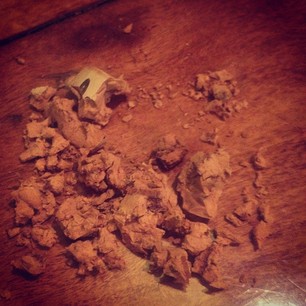Never assume that what is on the wine list is all the wine that is on offer at a restaurant. It pays to ask and minimally you may be surprised to find some alternatives wines not listed (wine received, but wine list not updated yet), or even be offered a wine from the owners private collection!
Today we had a most fabulous lunch at Bistro Molines in the Hunter Valley. The place is one of the very few Hatted restaurants in rural NSW. Robert and Sally Molines have been together for 40 years, and always in the food business. They are true food icons in the Hunter Valley. It is one of our very favorite restaurants, and every visit is a special occasion. For some really special occasions like our anniversary, we might bring along an exceptional bottle of wine from our cellar, but today, having a normal great lunch with great friends, I ordered wine off the wine list.
Bistro Molines has a nice selection of wines, including Australian and imported wines at very reasonable prices for a Hatted restaurant. After looking over the menu and the specials for the day, it became apparent that the four of us would all be having different starters and different mains. Therefore, I would have a bit of a challenge selecting wines that went well with every dish. We agreed as a table to venture forth with a Riesling over a Chardonnay for the white and selected a very nice Kabbinett Riesling from Mosel. The Riesling was sweet, but not too sweet, with a beautiful smooth texture. (Embarrassingly, I do not remember nor did I take a picture of the wine, so I do not remember the wine maker.)
For the red wine, I really wanted something with some age on it, but many of the really good choices were from 2010 or 2011. The wine list had a 2010 Cape Mentelle Zinfandel which is an outstanding wine. I have had the 2007 and 2008 vintages, including the 2007 vintage at Bistro Molines a year ago. While the 2010 vintage is considered a superior wine to the 2007, it should ideally be drunk from 2015 – 2030 and I felt it was far too young to drink this wine today. I asked if they still had any of the 2007 vintage around and after checking, the waitress told me they had one bottle left, but since they had a new order of the 2010 in, the wine list had been updated to show that.
While the 2010 vintage would be a better choice to drink in five years, it was not th best choice for today. The 2007 vintage would be far more mature and better drinking today so we selected that. While the 2007 vintage was not on the wine list, it was ours for the asking! Restaurants often have a number of wines which are single bottles left, or other special wines that do not appear on the wine list. Therefore, it is worthwhile asking if there is something in particular you are interested in.
Zinfandel is not widely grown in Australia, but if you are going to buy a Zindandel, make sure it is from Margaret River. Zinfandel grows best in Napa Valley and Margaret River is as close in climate and soil conditions as you are going to find in Australia. It is a lighter style of grape with texture similar to a Pinot Noir, but sweeter in general. The 2007 Cape Mentelle has flavors of blackberry and ripe raisins. It went well with the duck, the veal and the kidneys we had for mains (my wife continued to dring the Riesling to go with her mussels.)
Remember, even if you like what you see on the wine list, do not assume it is all that is on offer. By asking, you establish an intimacy with the sommelier or owner that will serve you well in getting some even better choices of wines not available to those who don’t ask!















